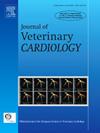Clinical and imaging characteristics of patent ductus arteriosus in Standard poodles and their crossbreeds
IF 1.3
2区 农林科学
Q2 VETERINARY SCIENCES
引用次数: 0
Abstract
Introduction/Objectives
Standard poodle (SP)/Standard poodle crossbred (SP-C) dogs have gained popularity with limited literature representation. The study objective was to report clinical, imaging, and procedural data in SP/SP-C dogs with patent ductus arteriosus (PDA).
Animals
Breeds included SP (12/30), Goldendoodle (9/30), Labradoodle (7/30), and Bernedoodle (2/30). At presentation, dogs were 0.6 years old (0.2–6.0) and weighed 14.8 kg (3.1–25.6). Nine had concurrent congenital heart disease. Thirteen required diuretic therapy.
Materials and Methods
A multi-institutional retrospective study including 30 client-owned SP/SP-C dogs was conducted. Data are reported as median and range.
Results
Intra-operative imaging was performed with angiography (n = 28) and transesophageal echocardiography (TEE) (n = 20), with discrepancies in morphology classification identified in six dogs in which both modalities were performed. Pulmonary ostium diameter measured by TEE, ampulla diameter 4 mm above the ostium measured by TEE (TEE-Amp4), ampulla diameter at the level of the aorta measured by TEE, and ampulla length were measured. Pulmonary ostium diameter measured by TEE was 4.1 mm (1.4–8.1), measuring 42% (35–66%) of the TEE-Amp4. Closure methods included the use of an Amplatz canine duct occluder (ACDO) device (27/30) and surgical ligation (3/30). The median ACDO size was 7 mm (3–12). Immediately after ACDO occlusion, TEE-Amp4 and ampulla diameter at the level of the aorta measured by TEE had a median increase of 21% (0–148) and 16% (4–59), respectively. Complications occurred in four dogs (intra-operative atrial fibrillation [2/30], device embolization following ampulla dilation with subsequent ligation [1/30], and postoperative death following PDA rupture with partial ligation [1/30]).
Study Limitations
Potential errors in breed identification and imaging could affect results.
Conclusions
Standard poodle and crossbred dogs can have large or unusually shaped PDAs, with TEE imaging able to provide anatomic information and intra-operative monitoring.
标准贵宾犬及其杂种犬动脉导管未闭的临床和影像学特征
标准贵宾犬(SP)/标准贵宾犬杂交(SP- c)犬已经获得了有限的文献代表性的普及。研究目的是报告患有动脉导管未闭(PDA)的SP/SP- c犬的临床、影像学和手术资料。动物品种包括SP(12/30),金毛贵宾(9/30),拉布拉多贵宾(7/30)和伯恩贵宾(2/30)。实验犬的年龄为0.6岁(0.2-6.0岁),体重为14.8 kg(3.1-25.6)。其中9人同时患有先天性心脏病。13例需要利尿剂治疗。材料与方法采用多机构回顾性研究,包括30只客户自备的SP/SP- c犬。数据以中位数和范围报告。结果术中影像学检查采用血管造影(n = 28)和经食管超声心动图(TEE) (n = 20),其中6只犬在两种方式下均发现形态学分类差异。TEE测定肺口直径,TEE测定壶腹直径,TEE测定壶腹直径,TEE测定壶腹直径,TEE测定壶腹直径,TEE测定壶腹长度,TEE测定壶腹直径,TEE测定壶腹直径,TEE测定壶腹长度。TEE测定肺口直径4.1 mm(1.4 ~ 8.1),测定TEE- amp4的42%(35 ~ 66%)。关闭方法包括使用Amplatz犬管闭塞器(ACDO)(27/30)和手术结扎(3/30)。ACDO的中位尺寸为7 mm(3-12)。ACDO阻断后即刻TEE- amp4和TEE测主动脉水平壶腹直径中位数分别增加21%(0-148)和16%(4-59)。4只狗出现并发症(术中心房颤动[2/30],壶腹扩张后器械栓塞并结扎[1/30],PDA破裂部分结扎后术后死亡[1/30])。研究局限品种鉴定和成像的潜在错误可能影响结果。结论标准贵宾犬和杂交犬可出现较大或形状异常的前列腺癌,TEE显像可提供解剖信息和术中监测。
本文章由计算机程序翻译,如有差异,请以英文原文为准。
求助全文
约1分钟内获得全文
求助全文
来源期刊

Journal of Veterinary Cardiology
VETERINARY SCIENCES-
CiteScore
2.50
自引率
25.00%
发文量
66
审稿时长
154 days
期刊介绍:
The mission of the Journal of Veterinary Cardiology is to publish peer-reviewed reports of the highest quality that promote greater understanding of cardiovascular disease, and enhance the health and well being of animals and humans. The Journal of Veterinary Cardiology publishes original contributions involving research and clinical practice that include prospective and retrospective studies, clinical trials, epidemiology, observational studies, and advances in applied and basic research.
The Journal invites submission of original manuscripts. Specific content areas of interest include heart failure, arrhythmias, congenital heart disease, cardiovascular medicine, surgery, hypertension, health outcomes research, diagnostic imaging, interventional techniques, genetics, molecular cardiology, and cardiovascular pathology, pharmacology, and toxicology.
 求助内容:
求助内容: 应助结果提醒方式:
应助结果提醒方式:


